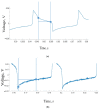Living-Neuron-Based Autogenerator
- PMID: 37631552
- PMCID: PMC10458024
- DOI: 10.3390/s23167016
Living-Neuron-Based Autogenerator
Abstract
We present a novel closed-loop system designed to integrate biological and artificial neurons of the oscillatory type into a unified circuit. The system comprises an electronic circuit based on the FitzHugh-Nagumo model, which provides stimulation to living neurons in acute hippocampal mouse brain slices. The local field potentials generated by the living neurons trigger a transition in the FitzHugh-Nagumo circuit from an excitable state to an oscillatory mode, and in turn, the spikes produced by the electronic circuit synchronize with the living-neuron spikes. The key advantage of this hybrid electrobiological autogenerator lies in its capability to control biological neuron signals, which holds significant promise for diverse neuromorphic applications.
Keywords: autogenerator; close-loop control system; hippocampal slice; hybrid neural circuit; neuron-like oscillator.
Conflict of interest statement
The authors declare no conflict of interest.
Figures










References
-
- Nagumo J., Arimoto S., Yoshizawa S. An active pulse transmission line simulating nerve axon. Proc. IRE. 1962;50:2061–2070. doi: 10.1109/JRPROC.1962.288235. - DOI
-
- Barba-Franco J.J., Gallegos A., Jaimes-Reátegui R., Gerasimova S.A., Pisarchik A.N. Dynamics of a ring of three unidirectionally coupled Duffing oscillators with time-dependent damping. Europhys. Lett. 2021;134:30005. doi: 10.1209/0295-5075/134/30005. - DOI
-
- Mikhaylov A.O., Komarov M.A., Levanova T.A., Osipov G.V. Sequential switching activity in ensembles of inhibitory coupled oscillators. Europhys. Lett. 2013;101:20009. doi: 10.1209/0295-5075/101/20009. - DOI
MeSH terms
LinkOut - more resources
Full Text Sources

